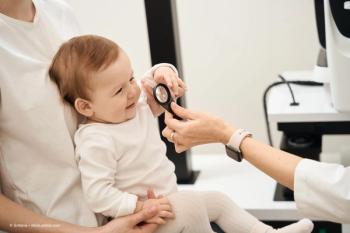
- Modern Retina Spring 2023
- Volume 3
- Issue 1
IOL designed for AMD offers hope for patients
Examining an intraocular implant that can sharpen vision for patients as disease progresses.
Age-related macular degeneration (AMD) is the most common cause of vision loss among adults in high-income countries. It affects 196 million globally, and projections suggest this number will rise to 288 million by 2040.1,2 The condition has no cure; it progresses over time as the area of lost vision spreads peripherally from the fovea.
Most individuals with AMD have the nonexudative (dry) form, in which the pigmented epithelial layer of the retina degenerates but no blood vessel changes occur. Lifestyle modifications such as smoking cessation and antioxidant supplementation can help slow the progression of nonexudative AMD, but no treatment exists. Maximizing daily functioning for patients with AMD means optimizing vision from the unaffected areas of their visual field.
It is common for the brain and eyes to adapt to the loss of central vision by using healthier areas of peripheral macula to see. But these areas don’t provide the same acuity as the fovea, and patients report blurred vision in addition to blind spots and dark patches.
Although low-vision magnification aids and peripheral vision training are available, the former can be aesthetically displeasing, restrict visual fields, and cause motion sickness, whereas the latter can require a lengthy and intense commitment to deliver noticeable results. A more immediate and practical solution lies with intraocular implants.
It’s not infrequent for patients with symptomatic AMD to have cataracts. Studies suggest that 20% of patients with cataracts also have AMD.3 Surgeons have an opportunity to improve the deterioration caused by both conditions with a single procedure, during which an intraocular lens (IOL) is inserted for sharp peripheral vision.
Standard IOLs, however, optimize vision within 5˚ of the fovea. As this is the area affected when vision loss begins, they fail to address the ongoing impact of AMD. To be useful to a patient with cataracts and AMD, an IOL needs to provide clear vision beyond 5˚.
I implant a foldable and injectable hydrophobic IOL (EyeMax Mono IOL; SharpView Ophthalmology) that improves image quality across the entire macula, spanning up to 10˚ from the fovea (equivalent to a 4-fold increase in the area covered when compared with standard IOLs). It allows optimal use of a preferred retinal focus (PRL) that sits outside the area of damage.
To date, I’ve implanted the IOL in the eyes of 30 patients. Nonexudative AMD has been the most common indication, but I have also implanted this lens in eyes with myopic maculopathies, stabilized exudative (wet) AMD, and even with a failed vitrectomy for a macular hole. I have noticed 3 advantages: a 10˚field, absence of prolonged pre- and postoperative PRL training, and lens performance.
IOL works as AMD progresses
Although this IOL will not cure AMD or slow its progression, it provides the next best outcome because of its generous field. Some monofocal IOLs can improve vision within 4˚ or 5˚ of the fovea, but once maculopathy extends beyond this, the benefit is lost and vision deteriorates. The 10˚ provided by this IOL is wide enough that as the disease progresses and the PRL moves further from the fovea, as long as it falls within the 10-degree zone, the patient will enjoy good visual acuity.
The lens continues to sharpen vision even as AMD progresses. One of my patients, a keen reader, came to me with nonexudative AMD. She was depressed because her maculopathy had progressed to a stage where she could no longer read.
After the procedure, she was able to read again, her depression improved, and the change in her was clear to see. That was 5 or 6 years ago, and she still can read. Her outcome is similar to that of most patients whom I have treated with the lens. I can recall only 1 patient with a surgery-resistant macular hole who did not see any improvement.
It is the ability of the lens to support vision as AMD progresses that attracts many surgeons to it. Users of this IOL across the globe—such as Jairo E. Hoyos Chacón, MD, of the Hoyos Ophthalmology Institute, in Sabadell, Spain—have said that although they began using it on patients with advanced AMD, they decide to use it in patients with earlier-stage disease after seeing the longevity of vision improvement it provides.
It is important to keep in mind that the IOL’s ability to function with disease progression depends on the patient’s disease profile. For the majority with stable AMD that progresses slowly, the lens will keep vision clearer for several years. For those who experience rapid and unpredictable progression, with a vision loss that may exceed the 10-degree area more quickly than expected, there will be a drop in visual quality despite implantation.
No need for pre- or postoperative training
The IOL is not the only intraocular device designed to maximize the peripheral vision of patients with nonexudative AMD and cataracts. Implantable miniature telescopes, telescopic IOLs, and add-on macular lenses such as the Scharioth lens are alternative options. But as telescopic, dual, or add-on implants for pseudophakic eyes, they have some limitations4 that make them most suitable for patients with conditions that indicate their use.
This IOL is also not the only single-piece IOL on the market for patients with AMD and cataract. Unlike others, it allows neuroadaptation to happen naturally without pre- or postoperative PRL training. Although training is not required with this IOL, I still like to encourage my patients to speed up acquisition of their best postoperative vision.
Favorable efficacy
and safety
The lens is a standard monofocal, which means that its implantation is like that of any standard cataract surgery. In my experience, it also has a safety and efficacy profile that is comparable to that of other monofocal lenses on the market. A consecutive case series of 244 patients with nonexudative or stable exudative AMD and cataract showed that implantation improved mean visual acuity by 18 ETDRS letters 3 months post surgery, whereas its peri- and postoperative safety outcomes were similar to those of standard IOL implantation.5
One question I’m often asked by other eye surgeons is, “Why would you use a monofocal IOL, given the obvious limitation of a monofocal design?” The answer is that the lens has an hyperaspheric profile that promotes transversal aberration and permits for a wider area of focus. Patients will need glasses to see at different distances, but the clarity of the vision achieved will be maintained for more years despite disease progression. Like many other surgical procedures, managing patients’ expectations and taking the time to explain are key to patient satisfaction.
Another reason I favor implanting a monofocal instead of a premium IOL in patients with AMD is that problems with reduced contrast sensitivity often arise with premium lenses. A patient with AMD already faces the challenge of blind spots and dark patches.
Perfecting patient selection
Although patients with nonexudative AMD comprise the bulk of those in whom I have implanted the lens, I’ve also had success using it for myopic maculopathy and even exudative AMD. The most important factor is not the type of maculopathy but disease stability. When I implant in a patient with exudative AMD, I do so only after they have been stabilized with intravitreal injections.
Another criterion is the absence of an existing IOL. This IOL offers the 2-in-1 solution for cataracts and AMD and cannot be inserted in front of another IOL.
Although this IOL is for patients with AMD and cataracts, I find it is possible, and advisable, to implant it in patients with AMD and mild cataracts. You will usually see signs of lens density changes in early-stage patients, indicating that cataract surgery is something they will need down the line—we’re just getting 1 step ahead of it.
Finally, the best candidates are patients with realistic expectations. It falls on us to communicate what the lens can and cannot do. Patients should be told that the lens will not restore lost vision or slow the progression of the maculopathy. It also won’t eliminate the need for glasses completely, as it is monofocal.
What it will do is reduce blurriness and sharpen images by helping them use the healthier areas of their macula to see more clearly, even as their condition progresses. This last part is key. This is why I use the lens in different types and stages of maculopathy. The lens is a long-term investment in vision that will usually work for many years. •
References
1. Wong WL, Su X, Li X, et al. Global prevalence of age-related macular degeneration and disease burden projection for 2020 and 2040: a systematic review and meta-analysis. Lancet Glob Health. 2014;2(2):e106-116. doi:10.1016/S2214-109X(13)70145-1
2. SharpView Ophthalmology. About Us. https://www.sharpviewophthalmology.com/about-us/
3. Weill Y, Hanhart J, Zadok D, Smadja D, Gelman E, Abulafia A. Patient management modifications in cataract surgery candidates following incorporation of routine preoperative macular optical coherence tomography. J Cataract Refract Surg. 2021;47(1):78-82. doi:10.1097/j.jcrs.0000000000000389
4. Grzybowski A, Wang J, Mao F. Wang D, Wang N. Intraocular vision-improving devices in age-related macular degeneration. Ann Transl Med. 2020;8(22):1549. doi:10.21037/atm-20-5851
5. Qureshi MA, Robbie SJ, Hengerer FH, Auffarth GU, Conrad-Hengerer I, Artal P. Consecutive case series of 244 age-related macular degeneration patients undergoing implantation with an extended macular vision IOL. Eur J Ophthalmol. 2018;28(2):198-203. doi:10.5301/ejo.5001052
Articles in this issue
over 2 years ago
Early detection and treatment of DR and DME are essentialover 2 years ago
Developments in gene therapy for inherited optic neuropathiesover 2 years ago
Vitrectomy: Is higher speed always better?Newsletter
Keep your retina practice on the forefront—subscribe for expert analysis and emerging trends in retinal disease management.















































